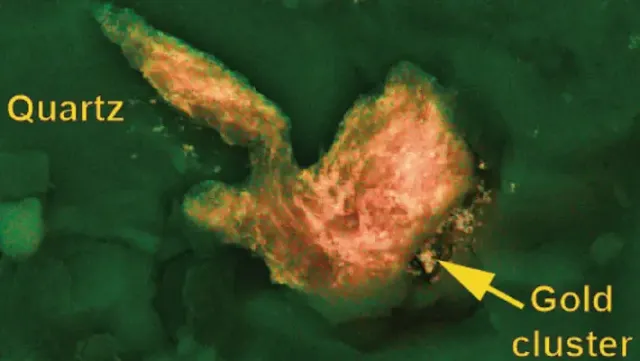How Earthquakes Might Create Massive Gold Nuggets
How Earthquakes Trigger the Formation of Giant Gold Nuggets in Quartz? Forces unleashed by quakes squeeze quartz enough to generate electric fields, driving formation of giant gold nuggets
 |
| Earthquakes Forge Giant Gold Nuggets in Quartz. |
For centuries, the process behind the formation of large gold nuggets has puzzled scientists. While the broad geological processes that create gold deposits were well understood, explaining how massive gold nuggets—often embedded in quartz—form from fluids with extremely low gold concentrations remained a mystery.
Recent study published in Nature Geoscience, led by geologists from Monash University, reveals that the unique electrical properties of quartz, activated by the immense forces of earthquakes, play a crucial role in the formation of these precious deposits.
Gold is frequently found within quartz veins, the second-most abundant mineral in Earth's crust after feldspar. These veins, created by hydrothermal fluids rich in gold seeping into cracks deep within the crust, should theoretically distribute gold evenly. Yet, in many cases, miners uncover large gold nuggets instead of uniformly dispersed grains. This has puzzled geologists, who wondered how such massive concentrations of gold could form from fluids with extremely low gold content—often just one part per million.
The formation of these nuggets was often attributed to the precipitation of gold from hot, water-rich fluids as they cooled or underwent chemical changes. However, this explanation fell short, especially considering the low concentration of gold in these fluids.
The mystery of how these large nuggets form has now been solved by the Monash University team. Their research focuses on piezoelectricity, a phenomenon where certain crystals, including quartz, generate an electric charge when subjected to mechanical stress. This effect was first discovered in the 1880s, but its role in gold formation had not been fully understood until now.
Earthquakes, common in areas where gold-bearing quartz veins are found, play a crucial role. Each tremor forces hydrothermal fluids, rich in dissolved gold, into cracks within quartz. The stress from these events causes quartz to produce electricity, which in turn facilitates the precipitation of gold from the fluid. This process not only explains why gold concentrates in quartz but also why large nuggets form. Over thousands of seismic events, what starts as microscopic gold particles can grow into nuggets weighing up to 130 pounds.
The team's experiments simulated the conditions quartz might experience during an earthquake. By applying stress to quartz crystals submerged in a gold-rich fluid, they found that the quartz generated enough electric voltage to cause gold nanoparticles to precipitate and accumulate on its surface.
 |
| Energy dispersive spectroscopic map of the sample studied by Voisey et al. Photo credit: Chris Voisey. |
The researchers placed a dozen small quartz tiles cut from natural crystal into aqueous solutions of gold. Half of the slabs were then jiggled 20 times a second for an hour to replicate a small quake, producing voltage of between 0.4 and 1.4 volts. The other half were left alone in their baths to act as controls.
Analysis with a scanning electron microscope revealed micrometer-sized gold grains had formed on the jiggled tiles, while none appeared on the controls. Subsequent tests using quartz tiles naturally speckled with grains of gold revealed the tiny 'seeds' bloomed further in solutions when a stress was applied.
Crucially, these tiny gold foundations took priority as nucleation sites of ore formation, with their presence reducing the chance of new gold grains forming nearby. Remarkably, this process favored the deposition of gold on existing gold grains, leading to the gradual formation of larger nuggets.
"Gold forms in quartz all the time," explains Dr. Chris Voisey, the study's lead author. "But the formation of really large gold nuggets was a bit of a conundrum. This finding explains why large gold nuggets are often found in or near quartz veins, particularly in regions with significant seismic activity.
Our study shows that the piezoelectric effect in quartz, triggered by the stress of earthquakes, lowers the energy barrier for gold nanoparticles to stick to existing gold grains, allowing them to grow into larger nuggets over time."
"The electric charge generated by quartz during earthquakes acts like a magnet for gold particles in the surrounding fluid," explains Voisey. This process not only accounts for the concentration of gold in specific locations but also why these nuggets can grow large over repeated seismic events.
"This process could explain why large gold nuggets are so often associated with quartz veins found in tectonically active areas or even rocks shattered by earthquakes," says Professor Andy Tomkins, a co-author of the study.
The study's implications extend beyond the academic sphere. Understanding the mechanism of gold nugget formation could potentially aid in the exploration and mining of gold deposits. While current technology can detect quartz veins deep within the Earth, it does not reveal whether these veins contain gold. However, the new findings suggest that areas with high tectonic activity and significant quartz presence could be prime targets for future gold exploration.
Despite these exciting discoveries, challenges remain. The piezoelectric effect in quartz, while powerful, is difficult to study on a large scale due to the complexity of measuring stress and electric fields within the Earth's crust. Further research will be needed to explore the specifics of this process, including the duration and intensity of the seismic forces required to form large gold nuggets.
Piezoelectricity could also explain why gold veins seem to 'float' in seams of quartz, with no obvious cracks or variations in geochemistry to account for their arrangement. Nothing but the whisper of a mineral lightning storm left by the trembling Earth to show gold dust where to gather.
In summary, this groundbreaking research demonstrates that earthquakes and the electrical properties of quartz play a fundamental role in the formation of large gold nuggets. By revealing the processes at work beneath the Earth’s surface, scientists have taken a major step forward in solving one of geology's most enduring mysteries.




%20(1).webp)



